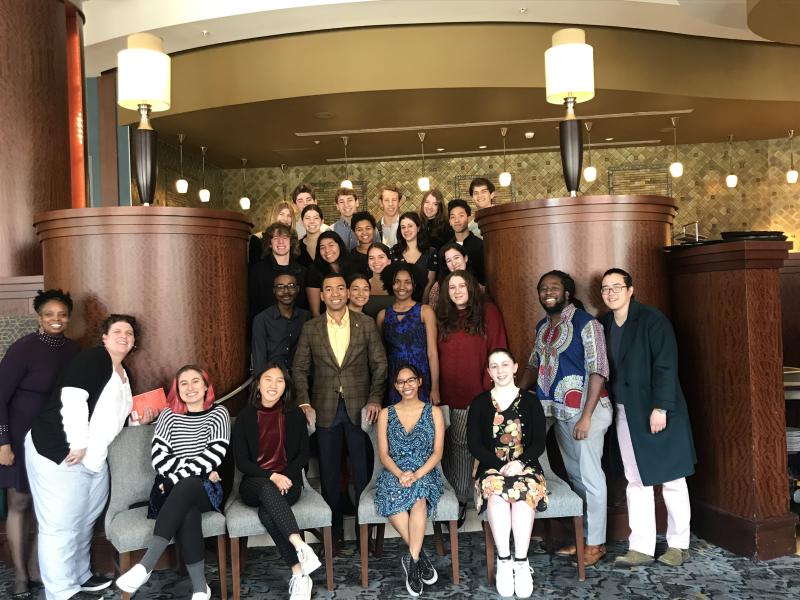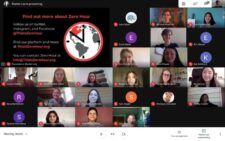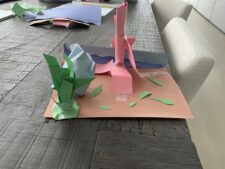When 22 ECFS students and four chaperones flew to Montgomery, Alabama, in February, their flight mirrored the history they would soon be studying — turbulent. The trip, organized by the Fieldston Upper School Ethics Department, gave juniors and seniors enrolled in ethics electives — Educational Inequality, Gender and Power, Social Justice and Liberation, and Crime and Punishment — the opportunity to see firsthand where many of the historical events they study took place. The group arrived late on Thursday and departed Sunday afternoon. In between was a weekend packed with experiences both devastating and uplifting, educational and inspiring.
“I chose to go on the trip because there’s nothing better than getting the full experience of what you’re learning by physically being there,” said Ryuichi N. ’21.
The group’s hotel was located in downtown Montgomery, which allowed them to walk everywhere during the weekend. This meant more than simply seeing the city and taking in the sights. “It was pretty powerful in terms of what walking means to Montgomery,” explained Rachel Ehrlich, Fieldston Upper School Ethics Chair. “The Montgomery bus boycotts took place there, the walk from Selma to Montgomery took place there.” By walking the city, ECFS students and faculty honored the history of the place where they were staying.
The first stop of the trip was to the Equal Justice Initiative (EJI) to visit the Legacy Museum: From Enslavement to Mass Incarceration, as well as the The National Memorial for Peace and Justice, the first memorial to document the era of racial terror lynchings in the United States. The EJI, founded by Bryan Stevenson, has documented over 4,000 — and growing — lynchings throughout American history.
Tinia Merriweather, Fieldston Upper School Ethics Teacher, knew that visiting EJI would be incredibly impactful for her. “Two of my grandparents are from Alabama,” she said. “I have generations of history as a descendent of enslaved African people.” To ensure that she could be as focused on the students as possible during their trip, Merriweather decided to visit Montgomery the previous weekend as well, to experience the city on her own. After both visits to EJI, Merriweather felt deeply moved by her experience. “I’m empowered,” she said. “I’m in awe of the strength and resilience of our people. I feel hope and a burden to create justice for others.”
Following the museum and memorial, ECFS students and faculty engaged in affinity group work. Students talked about moving through the spaces of EJI as a white person or a person of color, and how their race impacted their experiences. “We did talk about the complexities of identity — what it means to be white and Jewish, or white and queer, or white and a woman,” said Ehrlich. “We grounded our affinity groups in a racial consciousness because that’s what this is about.”
For Ryuichi, one of the highlights of the trip came the following day, when students had the opportunity to meet with lawyers from the Southern Poverty Law Center (SPLC) over breakfast. “What I found the most moving was the discussions we had with SPLC lawyers about the work they do,” he said. “We’ve been reading about their work in class, and it was empowering to hear their experiences directly.” The lawyers spoke to students about an ongoing case; they are suing the Alabama State of Corrections for mentally and physically abusing inmates. Following breakfast, students walked to the Montgomery County Jail House, where most people who are incarcerated in the area are held.
I’m in awe of the strength and resilience of our people. I feel hope and a burden to create justice for others.
The last morning of the trip, the students and faculty were treated to a once-in-a-lifetime experience: breakfast with current Mayor of Montgomery Steven Reed. The meeting was made possible by Merriweather, who reached out to the mayor’s office and appealed to their connection as graduates of Spelman and Morehouse, two historically black colleges with close ties. The students spent the weekend digesting the difficult history of Montgomery, and Merriweather was excited to have them witness something different by meeting Mayor Reed, the city’s first black mayor. “I don’t want our students to think of Montgomery as just what they know from history. I want them to see the new South and break up their stereotypes,” she said.
Over breakfast, students asked the mayor questions to better understand the culture and history of Montgomery, such as, “What is it like to have the first White House of the Confederacy around the corner from the Rosa Parks Museum?” Mayor Reed answered their questions thoughtfully, then fired back questions of his own, wanting the students to realize that New York City has its own complicated history of race and oppression.

The last stop before the airport was to Dexter Avenue Memorial Church for Sunday services. “We don’t feel like you can have a conversation about resistance and revolution in the South without talking about the black church,” explained Ehrlich. “That was a really powerful experience. There was wonderful singing and community and a great sermon about what it means to stand for justice in the face of a mob.”
Students and faculty arrived home late Sunday night and returned to school the following morning, tired from traveling but energized by their experiences in Montgomery.
“The students experienced joy being in community and learning with each other,” said Ehrlich. “I wouldn’t call it a fun trip, but I would call it a profoundly resonant trip.”
“I left inspired and recommitted to the work of social justice,” said Merriweather. “I feel grateful that I am an educator, grateful that I was able to bring students. It was one of the most powerful things I’ve been a part of in the 24 years I’ve been a teacher.”



